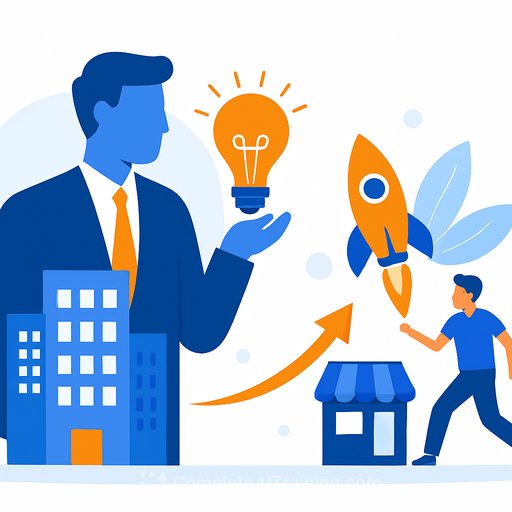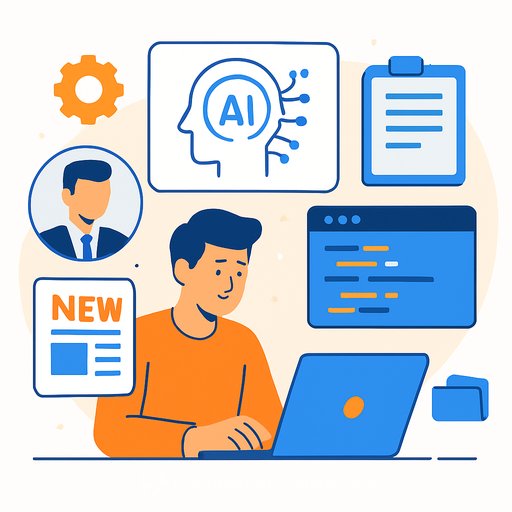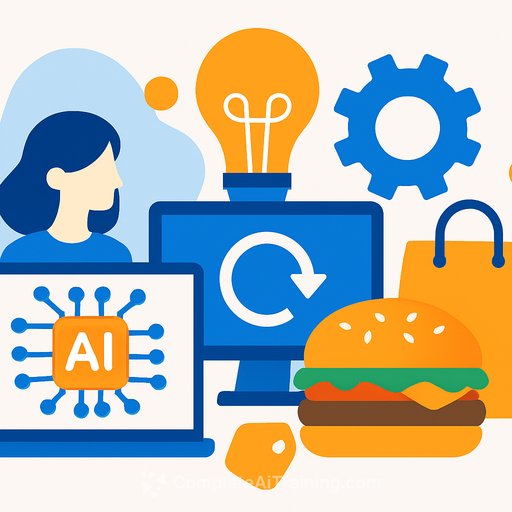AI Entrepreneurship's Core Question: Will Giants Learn to Innovate Faster, or Will Startups Win Distribution First?
Everyone feels the noise. Few see the signal. Before you go all-in, face the core question: will tech giants figure out how to innovate faster than startups figure out how to get distribution?
If you build products, this isn't theory. It sets your hiring plan, architecture, GTM, and funding path. Use the questions and playbooks below to make clear calls.
The Home Screen Test
Count the apps on your home screen that are truly AI-native. Most people stop at ChatGPT or a notes app with autocomplete. That gap is the opportunity.
AI-native means context-aware, proactive, and outcome-driven. It reduces clicks, writes the draft, handles the handoff, and learns from usage. Ask: where is the AI-native calendar, CRM, or social app? Your roadmap should aim at these gaps.
- Run a "home screen audit" across your team. List tasks that still require five taps and a copy/paste.
- Define AI-native criteria: fewer steps, task completion, memory, and safe autonomy (bounded agents).
- Prototype one workflow end-to-end. Measure time saved and task completion rate, not just features shipped.
Will Teams Get Smaller or Bigger?
One narrative says a single builder can direct a swarm of AI agents and ship like a 50-person team. The counterpoint: many business functions still require taste, trust, and manual work-design, ops, compliance, sales.
- Early stage: 3-6 people plus agents can cover PM, design, FE/BE, data, and QA.
- As you scale: expect headcount in design, partnerships, customer success, and compliance to grow.
- Use agents for generation and checks, humans for decisions and taste. Write this into your SDLC.
Moats When Everyone Ships Fast
If features converge, your edge must come from compounding effects. Make distribution, data, and speed work together.
- Distribution: own a channel (embedded in a workflow, default in a toolchain, or a strong community). Network effects still matter (reference).
- Proprietary data loops: append unique, permissioned data every day. Ship features that increase data quality and consent.
- Velocity: weekly releases, model swaps without rewrites, and a habit of shipping v0 in days.
- Trust: audit trails, evals, and safe-ops for agents. Enterprises buy reduction of risk.
- Hard-to-copy integrations: capital-heavy, regulated, or hardware-linked layers that take time to replicate.
Will Building Get Cheaper or More Expensive?
Coding and design got cheaper. Growth did not. You still pay for attention, onboarding, and trust.
- Budget 1:3 (build:grow) once you find a sharp use case.
- Prove pull before paid: target one underserved workflow, get 100 daily users, then turn on paid channels.
- Price on outcome: time saved, tasks completed, pipeline created-not tokens or seats alone.
How to Organize Product, Design, and Engineering
Multimodal inputs compress roles. PRDs become UI, UI becomes code, code spawns tests. Don't erase roles; tighten loops.
- One owner for problem framing (PM), one owner for experience (Design), one owner for systems (Eng).
- Shared toolchain: prompt libraries, component systems, codegen with guardrails, evals for models and agents.
- Ship cadence: weekly bets, daily diffs, automated eval dashboards, rollback plans.
Where to Build: Bay Area or Distributed?
The Bay Area still concentrates capital, talent, and partners. But shipping a product now feels closer to content creation: you can do it from anywhere.
- Early: build distributed, travel for capital and key partners when needed.
- Later: colocate a small core for speed weeks; keep the rest async and process-driven.
What Happens to Venture Capital?
If two people can hit revenue quickly, funding looks different. Expect more revenue-first bets and global checks for growth, not research.
- Path A (product-first): build to $20-50k MRR, then raise to scale distribution.
- Path B (distribution-first): secure channel partnerships, then build to fit the channel.
- Pitch model-agnostic architecture and a clear data moat. Investors will ask how you avoid model lock-in.
Do Pre-Seed/Seed/Series Labels Still Help?
Some products will jump from zero to Series A once usage proves durable. Others should stay as side projects until a clear pull appears.
- Gate raises by proofs: DAU/WAU > 35%, retention curves flattening, data loop compounding, CAC payback < 6 months.
- If you lack these, keep experiments cheap. Kill slow-burn projects fast.
Historical Signal
Work moved from family shops to factories to firms with managers. AI agents and cheap compute are the next organizing force. Today's structures won't fully fit tomorrow's productivity.
Plan for new units of work: tasks, agents, and supervisors instead of only tickets and teams.
What AI-Native Looks Like (Product Checklist)
- Context: pulls calendar, docs, CRM, and settings with consent.
- Proactive: surfaces next best action without a prompt.
- Outcome-first: presses the button for the user and confirms.
- Memory: improves with usage, safely and transparently.
- Agents: bounded autonomy, clear handoffs, logs, and rollbacks.
- Safety: red-team prompts, eval suites, PII handling, and human overrides.
Practical Playbook for Product Teams
- Pick one painful workflow with daily frequency and clear outcome.
- Design for "no prompt" first. Let the system propose actions.
- Go model-agnostic: abstraction layer for LLMs, embeddings, and tools. Swap models without changing UX.
- Build a data flywheel: what data improves the model tomorrow, and how do you earn consent for it?
- Ship a thin wedge in 3 weeks. Measure tasks completed and minutes saved.
- Automate QA: regression prompts, golden sets, and drift alerts.
- Instrument trust: hallucination rate, unsafe action rate, and rollback frequency.
- Secure distribution: embed where work already happens (email, calendar, CRM, IDE).
- Monetize on outcomes: tier by volume of tasks completed or dollars influenced.
- Create a partnership map with giants and top SaaS-distribution beats feature parity.
- Set kill criteria upfront: if usage or retention misses target by week 6, pivot or cut.
- Review weekly: ship, measure, learn, repeat. No long stealth cycles.
Who Wins: Giants or Startups?
Two scenarios can both be true in different markets.
- Giants learn to innovate: they bolt AI into existing products and win through distribution and trust. Your play: be the best feature, integrate deeply, and sell the picks and shovels.
- Startups win distribution: they find new channels, own the workflow, and compound data. Your play: focus on one job to be done, build the data loop, and secure a repeatable channel.
Risks You Must Manage
- LLM brittleness and drift: use evals and canaries; expose confidence to users.
- Privacy and compliance: PII boundaries, data retention settings, and audit logs.
- Liability: human-in-the-loop for high-impact actions; clear user confirmations.
- Vendor risk: multi-model strategy; shadow stack ready to swap.
12-Month Roadmap Template
- Q1: Ship v0 wedge, 100 daily users, baseline evals, first integration.
- Q2: Data loop live, retention proof, second integration, outcome pricing.
- Q3: Channel partnership, enterprise trust features, rollouts by segment.
- Q4: Model swap without rewrites, agent autonomy step-up, CAC payback under 6 months.
Key Decision: Innovation vs Distribution
Decide your bias early. If you bet on innovation speed, build a release machine and a data moat. If you bet on distribution, become a dependency inside the tools people already use.
The winners will do both-ship faster than copycats and get into users' hands before the giants wake up.
Further learning
- What network effects look like in practice
- Curated AI courses by job role
- Practical AI tools for engineering teams
Your membership also unlocks:






